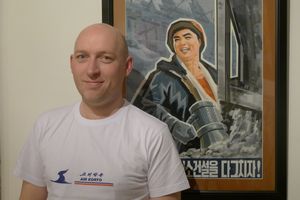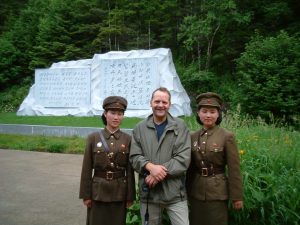Memo #290
Despite the often invoked image of North Korea as a closed, “Hermit Nation,” tourists—mainly from China, but also from Western countries—do visit there, currently to the tune of around 15,000-20,000 visitors per year. Of these, some 5000 are citizens of Western countries. For over a decade now, Koryo Tours, under the leadership of Nick Bonner and Simon Cockerell, has been the leading travel company escorting such Western visitors to North Korea. But the company has not limited itself to leading tour groups; it has been involved in facilitating a number of cultural exchanges, and Nick Bonner, the company’s founder, has directed and produced documentaries on North Korea, among them films by Daniel Gordon such as The Game of their Lives (천리마 축구단) (2002) and Crossing the Line (푸른 눈의 평양시민) (2006).
This month, the APM’s editor Hyung-Gu Lynn sat down virtually with Nick Bonner and Simon Cockerell to pose some questions on their involvement in cultural exchanges and initiatives with North Korea.
Hyung-Gu Lynn (HGL): When you made your first trip to North Korea (NK) what was the process of getting a visa compared to now? NK’s foreign relations were more limited (at least in terms of normalization with the UK, Canada, and other countries) and the diffusion of web-based platforms for applications and the like were certainly less common.
Simon Cockerell (SC): In my case, when I made my first visit in 2002 the application process was pretty much the same as it is now. There hasn’t been much of a change at all in how this process works. While some minor alterations happen every year in the exact make-up of the information we are required to send, and in how it is laid out, the fundamentals of needing people’s passport data, addresses, and so on has remained a constant.
The largest change though has been in not needing letters from the employers of applicants anymore. This was a real hassle to obtain in some cases (what we needed were confirmation letters from the employer stating that so-and-so worked at such a company, and in what position). Not needing to ask each tourist for this document was a great relief!
HGL: You (Nick Bonner) were involved as co-director of the film “Comrade Kim Goes Flying” (김동무는 하늘을 난다) (2012). How many years of planning and production did it take? Or if possible, can you take us through a brief outline of the production process?
Nick Bonner (NB): Pre-production started in 2006 and the premier was at the Toronto International Film Festival in 2012. It was the same process as making any film in any country but with the exception that making anything in North Korea is perhaps not as straightforward as it would be in the West. The script writing was perhaps the most difficult process—to work with the North Koreans to produce a script that was something they have not written about before, their first ever “girl power” movie. “Comrade Kim Goes Flying” was the first time a North Korean audience had seen a film which was made without a political message but simply for entertainment. It was the first North Korean film to be fully edited outside the country and the post-production was completed in Belgium. Belgian producer Anja Daelemans and myself therefore had unprecedented freedom to work on the film—it was a co-production in the truest sense. As well as premiering at the Toronto International Film Festival perhaps the highlight was that the film was selected for the Busan International Film Festival, the first time a North Korean film was shown to a public audience in South Korea.
HGL: Tell us a bit more about the “Beautiful Future” exhibit? Who initiated it, for example, where can you see it, etc.?
NB: The Beautiful Future was a collaboration between myself and Dominic Johnson-Hill of Plastered 8, and a group of North Korean artists working for a marketing production studio. We worked with the North Korean artists over a two-year period to develop these unique pieces from sketches to portray a place lost in time, an imagined future, where all is bright and beautiful.
The paintings represent the rituals of life in today’s China set on a stage of early Chinese socialism. As outsiders looking in, the producers imagine a China that retains its socialist traditions – with icons being the great symbols of Chinese society today. Workers and peasants parade towards a glorified CCTV tower in the heart of Beijing’s CBD with factories and the Great Wall in the distance. People stream into an office waving red flags with tractors working the fields outside, the camaraderie of daily work played out amidst a maze of cubicles in towering office blocks, the rise of the information age slowly replacing the industrial production.
Through this close collaboration we discover a conversation, a life imagined and celebrated between two worlds, a unique and beautiful future. We are showing the works at Taipei Arts Museum as part of an exhibition in May.
HGL: As aficionados of soccer/football, have you seen any matches live (international, men’s and women’s, junior, club level – 최상급축구련맹전, etc.) and how would you describe the styles of play? Were there any notable differences by clubs, in the matches you saw for example? How about fan reactions?
SC: Yes I have seen a great many football matches in the DPRK, youth football, men’s women’ international and domestic. We try to go to as many games as possible and it is often one of the highlights of the trip for tourists.
There is not a great variation in the style of play between different domestic teams; they all seem to play fundamentally in the same way. This can make the games a little less exciting than a clash between two different styles. The men’s teams are not particularly good (on a global scale I mean) but the women’s teams are very, very good indeed.
For most domestic games the number of spectators is very low, just a few hundred, so most of the stadium is empty. For some internationals though a capacity crowd in Kim Il Sung stadium can be achieved; something in the order of 50,000 people at a maximum. However, I’ve seen a full house in a game against Japan, and an almost empty stadium in a match with Australia, you never really know until you show up!
HGL: The visit to North Korea of the New York Philharmonic seems to have become a fast-fading memory. Are there specific details of the preparation and the concert itself that you might be able to provide that did not receive much attention in the media?
NB: Koryo Tours was involved in some of the preparations for the concert. Perhaps the most beautiful moment was at the end of the concert that only a few people saw–the majority of the audience had left but at the front rows a number of Koreans were shuffling out intrigued with watching the musicians who were picking up their instruments and heading off-stage. There were only 200 or so members of the audience left when either a Korean waved to an American or vice versa but a spontaneous applause erupted with Koreans clapping the orchestra and the orchestra clapping the Korean audience. It went on for over 5 minutes until the conductor was brought back on stage and it continued for several minutes—stunning. During “An American in Paris” the North Koreans tapped their feet to the rhythm of this beautiful piece–then perhaps realised this was not the thing to do and tried to control themselves.
-
Links:
- Hyung-Gu Lynn, “Visual Anthropology – Review Essay: ‘Kimjongilia’ and ‘Crossing the Line,’” American Anthropologist 113, no. 1 (2011): 156-158
- Kyung-Ae Park and Mark Bennett, “Engaging North Korea with High-culture Soft Power: Knowledge Sharing with Pyongyang,” Pacific Affairs 87, no. 1 (2014): 29-41.
Related Memos:
See our other memos on North Korea, South Korea, and the United Kingdom.


Comments are closed, but trackbacks and pingbacks are open.